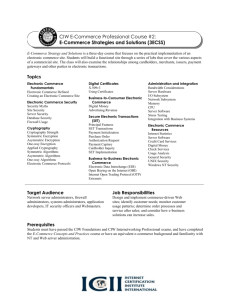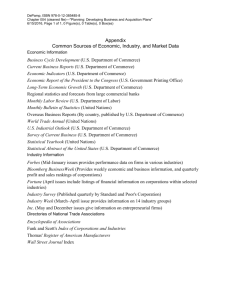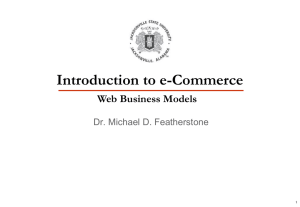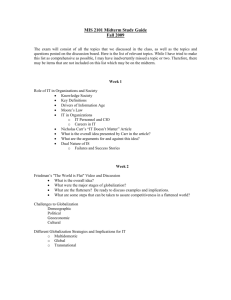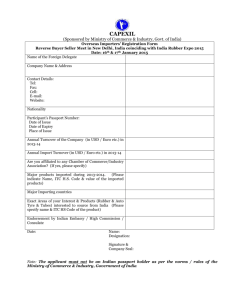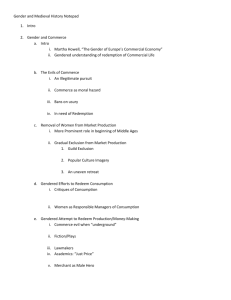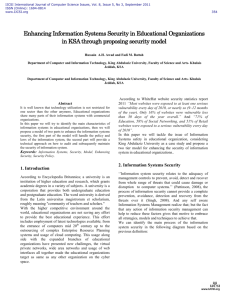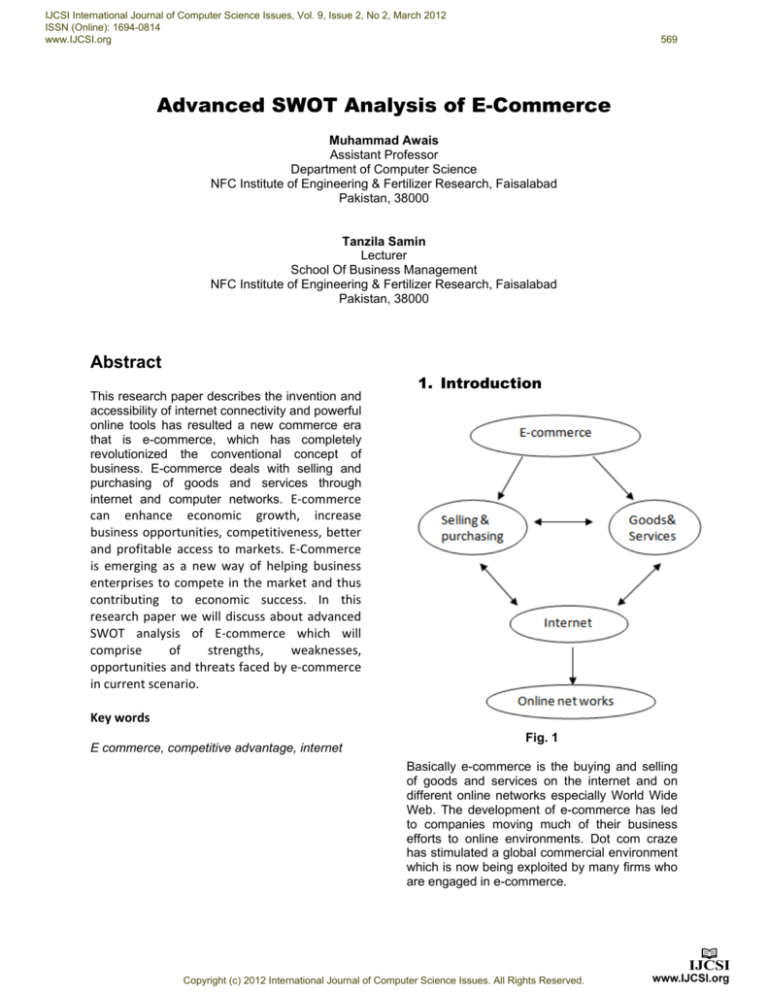
IJCSI International Journal of Computer Science Issues, Vol. 9, Issue 2, No 2, March 2012
ISSN (Online): 1694-0814
www.IJCSI.org
569
Advanced SWOT Analysis of E-Commerce
Muhammad Awais
Assistant Professor
Department of Computer Science
NFC Institute of Engineering & Fertilizer Research, Faisalabad
Pakistan, 38000
Tanzila Samin
Lecturer
School Of Business Management
NFC Institute of Engineering & Fertilizer Research, Faisalabad
Pakistan, 38000
Abstract
This research paper describes the invention and
accessibility of internet connectivity and powerful
online tools has resulted a new commerce era
that is e-commerce, which has completely
revolutionized the conventional concept of
business. E-commerce deals with selling and
purchasing of goods and services through
internet and computer networks. E‐commerce 1. Introduction
can enhance economic growth, increase business opportunities, competitiveness, better and profitable access to markets. E‐Commerce is emerging as a new way of helping business enterprises to compete in the market and thus contributing to economic success. In this research paper we will discuss about advanced SWOT analysis of E‐commerce which will comprise of strengths, weaknesses, opportunities and threats faced by e‐commerce in current scenario. Key words
E commerce, competitive advantage, internet
Fig. 1
Basically e-commerce is the buying and selling
of goods and services on the internet and on
different online networks especially World Wide
Web. The development of e-commerce has led
to companies moving much of their business
efforts to online environments. Dot com craze
has stimulated a global commercial environment
which is now being exploited by many firms who
are engaged in e-commerce.
Copyright (c) 2012 International Journal of Computer Science Issues. All Rights Reserved.
IJCSI International Journal of Computer Science Issues, Vol. 9, Issue 2, No 2, March 2012
ISSN (Online): 1694-0814
www.IJCSI.org
570
deve
eloped well into the early 1990s.A wide
rang
ge of busine
ess activitiess are relate
ed to
interrnet e.g. inte
ernet comme
erce (i-comm
merce)
virtual commerce(v-commerce
e) cyber comm
merce
ommerce)
web
commerrce(w(c-co
commerce).The use
u
of intern
net has made the
d a global viillage. The use of interne
et has
world
redu
uced the disstances and has brough
ht the
peop
ple together. A nation’ss back bon
ne is
commerce and it will be stren
ngthened if ba
acked
by electronic tools in which e-commerce pllays a
mportant featu
ure in e-comm
merce
vital role. The im
ecurity which not only incre
eases
is prrivacy and se
competitive advan
ntage but con
nfidence levell also.
ommerce brin
ngs sellers an
nd potential buyers
b
E-co
at th
he distance off one click an
nd it saves tim
me as
it is cost effective
e, as e-comm
merce is beco
oming
t success.
key to
According
g to the edito
or-in-chief of International
Journal of Electronic Commercce, Vladimirr
mmerce is sharing businesss
Zwass, Ellectronic com
informatio
on, maintainin
ng business relationshipss
and conducting busine
ess transactio
ons by meanss
mmunication networks.[1]H
He mentioned
d
of telecom
that in itss purest form e commerce
e has existed
d
for over 40
4 years origiinating from the
t electronicc
transmisssion of messa
age during the
e Berlin airliftt
in 1948.F
From this,[2]electronic data
a interchange
e
was the next
n
stage of e commerce development
d
.
In 1960 a cooperative
e effort betw
ween industryy
groups produced
p
a first
f
attempt at common
n
electronicc data formats. The form
mats howeverr
were onlyy for purcha
asing, transp
portation and
d
finance data and werre used primarily for intra
a
t
e
industry transactions.
It was not until the late
1970s tha
at work bega
an for nation
nal Electronicc
Data Intterchange (EDI)
(
stand
dards which
h
:
2. E-c
commerc
ce Proces
sses:
According
g to our view
v
point process off
e-commerce takes pllace under the
t
following
g
as
shown
n
in
the
e
diagram
m
steps
Order
delivery
Shipm
me
nt
Compan
y/Custo
mer
Internet
Orde
er
E-c
commerce
e
Orrder
fulfiillme
n
nt
Shoppin
g cartt
E-ma
ail
notific
cati
on
On
nline
trans
sactio
n
Fig 2
As a company and a customer brow
wses through internet to accquire his/her required prod
duct’s informa
ation
n he/she is completely satissfied by produ
uct’s featuress, its competitive advantage
es, comparing
g it
and when
with otherr products the
en he/she placces an order for the product for which he/she
h
has se
et up his/her mind
m
to buy and
d for this purp
pose he/she chooses
c
onlin
ne transaction
n option and th
he selling com
mpany notifies
him/her th
hat they have got the requiired payment and now theyy will fulfill hiss/her order an
nd it will be
delivered very soon.
Copyright (c) 2012 International Journal of Computer Science Issues. All Rights Reserved.
IJCSI International Journal of Computer Science Issues, Vol. 9, Issue 2, No 2, March 2012
ISSN (Online): 1694-0814
www.IJCSI.org
571
3. Advanced SWOT Analysis of E-commerce
Strengths
Weaknesses
Boundary less (global location)
Security
Time saving
Fake websites
No time constraints
Fraud
Price/product comparison
Fewer discounts and bargaining
Cost effective
Long delivery timing
Direct communication with consumer
No idea about quality and physical condition of
Improved customer interaction
Flexible target market segmentation
Limitation of products
Simple and easier exchange of information
Lack of personal services
Lowers transaction cost
More shipping cost
Easy arrangement of products
Limited exposure
Faster buying procedure
Limited advertising
No physical company set up
Customer’s satisfaction
Easy transactions
Niche products
Low operating cost
the product
Opportunities
Threats
Changing trends
Competitors
New technologies
Changes in environment, law and regulations
Global expansion
Innovation
High availability (24 hour and seven days a week)
Privacy concerns
Wide business growth
Fraud
Cut down on local competition
Risk
Advertising
Fig 3
Copyright (c) 2012 International Journal of Computer Science Issues. All Rights Reserved.
IJCSI International Journal of Computer Science Issues, Vol. 9, Issue 2, No 2, March 2012
ISSN (Online): 1694-0814
www.IJCSI.org
Strengths:
Boundary less (global location):
E-commerce can be dealt globally as no
specific boundary is required. It enables all
the companies to expand them to global
level.
Time saving:
It saves time and transportation. Because
there is no need to go anywhere physically.
No time constraints:
It can be used any where any time as there
is no time constraints.
Price/Product comparison:
Helps consumers to compare price and
product effectively and efficiently.
Cost effective:
Reduces logistical problems and puts a
small business on a par with giants.
Direct communication with consumer:
Social networking sites, online advertising
networks can be mediums to buzz about
online store.
Improved customer interaction:
Quick feedback and comment forms are
main features to interact with customers.
Flexible target market segmentation:
Target market segment here in e commerce
is flexible can be modified any time.
Simple and easier exchange of
information:
Improves information sharing among
merchants and customers and enables
prompt quick just in time
deliveries.
.
Lowers transaction cost:
Things can be automated in a well
implemented online store. If online
download facility is available
then distribution cost can be cut off.
Easy arrangement of products:
Products can be arranged in the shelves
within minutes. With online store it is quite
easy.
572
Faster buying procedure:
E commerce means better and quick
customer services.
Online customer
services make customer happier. Due to
absence of intermediaries for buying
products. So buying procedure will be fast
and quick.
No physical company set up:
Doing e business is cost effective because
no physical set up is required for that.
Easy transactions:
Financial transactions through electronic
fund transfer are very fast and can be done
from any part of the world.
Niche Products:
Almost everything can be sold on internet.
Even if products targeted to smaller markets
the buyer will be somewhere on net.
Low operating cost:
It can be started and continued with very
low investment. Staff cost is very low.
Weaknesses:
Security:
Security matter confuses customers
especially about the integrity of the payment
process.
Fake websites:
Fake websites can not only disgrace e
commerce but bring bad name to e
commerce also.
Fraud:
Concerns about misuse of financial and
personal data is a great weakness in e
commerce.
Fewer discounts and bargaining:
Hardly online businesses offer discounts
and bargaining cannot be possible.
Long delivery timing:
Delivery time can be in days or weeks which
one cannot wait for.
No idea about quality and physical
condition of the product:
Online products cannot be touched, wear or
sit on the products.
Copyright (c) 2012 International Journal of Computer Science Issues. All Rights Reserved.
IJCSI International Journal of Computer Science Issues, Vol. 9, Issue 2, No 2, March 2012
ISSN (Online): 1694-0814
www.IJCSI.org
573
Limitation of products:
Limited number of products can be
available.
Wide business growth:
E business has wide scope and broader
vision to grow.
Lack of personal services:
Physical products can be available but lack
in personal services which are intangible.
Cut down on local competition:
Online customer services is a competitive
advantage for the company.
More shipping cost:
Shipping cost increases if we order online.
Advertising:
Advertising is cost effective as compare to
conventional offline system.
Limited exposure:
In developing areas where internet is not
accessible will have no or little exposure to
e commerce.
Limited advertising:
Limited advertising opportunities are
available because in e commerce one
cannot go for mass advertising.
Customer’s satisfaction:
There is no interaction between customer
and the seller. Therefore the scope of
convincing the customer does not exist.
Many times customers prefer to buy the
product by reaching personally to
the market rather than purchasing through
internet.
Threats:
Competitors:
Competition is increasing day by day big
companies have already entered in this
field. They are making people habitual at
the cost of their companies.
Changes in environment, law and
regulations:
Change in trends, fashion and fad can
distress E Commerce side by side change in
law and regulations can also affect it.
Innovation:
Customers now a days are always in a
search of innovative products. Innovation
can be either in product, place, promotion
and even price.
Privacy concerns:
Fears that information can be misused lead
to spam e mail or identity fraud.
No direct interaction:
In e commerce there is no direct interaction
of customer and the seller. Thats why
bargaining does not exist. People prefer to
buy physically a compare to online.
Fraud:
Persons using unfair means to operate e
commerce can damage the confidence and
faith of common people.
Risk:
Nature of fraud and risk is different because
when a customer relies on un seen set up,
he trusts and makes transactions. In such a
way he is ready to face risk.
Opportunities:
Changing trends:
E commerce is fast and effective even
financial transactions can be made from any
part of the world.
People of tomorrow will feel more
comfortable to buy products through internet
only.
New technologies:
Daily number of internet users is increasing.
People feel more comfortable to shop
online.
Global expansion:
E commerce can be operated any where
any time without any interruption.
High availability (24 hour and seven days
a week):
Along with each and every click of the
mouse business is in operation.
Copyright (c) 2012 International Journal of Computer Science Issues. All Rights Reserved.
IJCSI International Journal of Computer Science Issues, Vol. 9, Issue 2, No 2, March 2012
ISSN (Online): 1694-0814
www.IJCSI.org
4. Conclusion:
A developing country can be rationalized and
mechanized if it introduces e-commerce
effectively and efficiently. It will enhance its
output and gives competitive advantage.
Information Technology (IT) has boosted ecommerce worldwide. Now it’s easier to enter to
a new market and one can evaluate his/her
product and company’s performance. It reduces
business overhead and enhances business
management.
References:
[1] V. Zwass, ‘Structure and macro-level impacts
of electronic commerce: from technological
infrastructure to electronic marketplaces’,
http://www.mhhe.com/business/mis/zwass/ecpa
per.html (accessed May 2001).
[2] T. Seideman, ‘What Sam Walton learned
from the Berlin airlift’, Audacity: The Magazine of
Business Experience, Spring 1996, 52–61.
[3] Boateng, R., Hinson, R., Heeks, R. and Molla
A. (2008). Ecommerce in LDCs: Summary
Evidence and Implications. Journal of African
Business, 9(2) 257-285.
[4]
emarketer.com/products/report.php?easia/welco
me.html>.
Copyright (c) 2012 International Journal of Computer Science Issues. All Rights Reserved.
574

